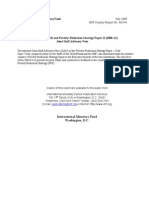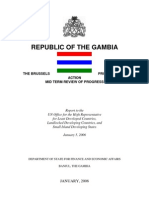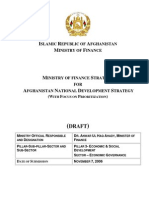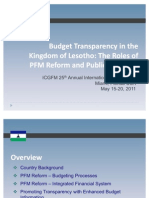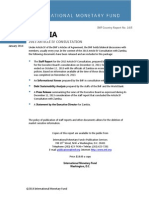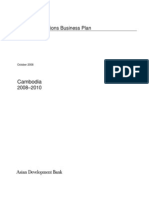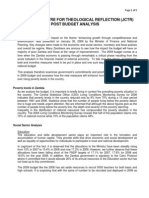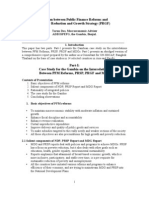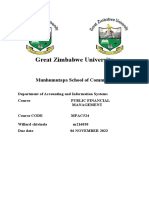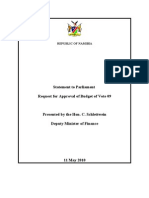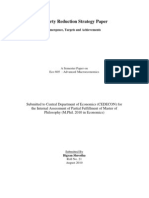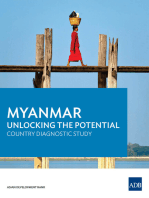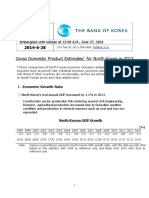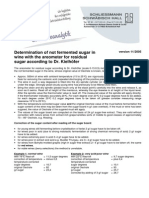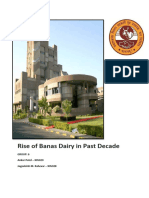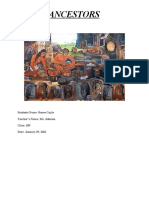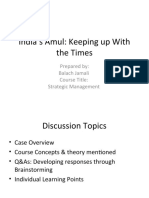0 ratings0% found this document useful (0 votes)
53 viewsPoverty Reduction
Poverty Reduction
Uploaded by
dinnovation5473The document summarizes Malawi's third annual progress report on its Poverty Reduction Strategy. It commends improvements in macroeconomic performance but notes risks remain. It recommends greater private sector and parliamentary participation in reviews. Future reports could include annual sector targets and discuss challenges to maintaining stability.
Copyright:
© All Rights Reserved
Available Formats
Download as PDF, TXT or read online from Scribd
Poverty Reduction
Poverty Reduction
Uploaded by
dinnovation54730 ratings0% found this document useful (0 votes)
53 views11 pagesThe document summarizes Malawi's third annual progress report on its Poverty Reduction Strategy. It commends improvements in macroeconomic performance but notes risks remain. It recommends greater private sector and parliamentary participation in reviews. Future reports could include annual sector targets and discuss challenges to maintaining stability.
Original Description:
Poverty Reduction
Copyright
© © All Rights Reserved
Available Formats
PDF, TXT or read online from Scribd
Share this document
Did you find this document useful?
Is this content inappropriate?
The document summarizes Malawi's third annual progress report on its Poverty Reduction Strategy. It commends improvements in macroeconomic performance but notes risks remain. It recommends greater private sector and parliamentary participation in reviews. Future reports could include annual sector targets and discuss challenges to maintaining stability.
Copyright:
© All Rights Reserved
Available Formats
Download as PDF, TXT or read online from Scribd
Download as pdf or txt
0 ratings0% found this document useful (0 votes)
53 views11 pagesPoverty Reduction
Poverty Reduction
Uploaded by
dinnovation5473The document summarizes Malawi's third annual progress report on its Poverty Reduction Strategy. It commends improvements in macroeconomic performance but notes risks remain. It recommends greater private sector and parliamentary participation in reviews. Future reports could include annual sector targets and discuss challenges to maintaining stability.
Copyright:
© All Rights Reserved
Available Formats
Download as PDF, TXT or read online from Scribd
Download as pdf or txt
You are on page 1of 11
2006 International Monetary Fund October 2006
IMF Country Report No. 06/339
Malawi: Poverty Reduction Strategy PaperThird Annual Progress Report
Joint Staff Advisory Note
The attached Joint Staff Advisory Note (JSAN) of the Poverty Reduction Strategy Paper Third
Annual Progress Report for Malawi, prepared jointly by the staffs of the World Bank and the IMF,
was distributed with the member countrys Poverty Reduction Strategy Paper Third Annual Progress
Report to the Executive Boards of the two institutions. The objective of the JSAN is to provide
focused, frank, and constructive feedback to the country on progress in implementing its Poverty
Reduction Strategy (PRS).
To assist the IMF in evaluating the publication policy, reader comments are invited and may be
sent by e-mail to publicationpolicy@imf.org.
Copies of this report are available to the public from
International Monetary Fund Publication Services
700 19
th
Street, N.W. Washington, D.C. 20431
Telephone: (202) 623-7430 Telefax: (202) 623-7201
E-mail: publications@imf.org Internet: http://www.imf.org
International Monetary Fund
Washington, D.C.
INTERNATIONAL DEVELOPMENT ASSOCIATION
AND INTERNATIONAL MONETARY FUND
MALAWI
Joint Staff Advisory Note on the Poverty Reduction Strategy Paper
Third Annual Progress Report
Prepared by the staffs of the International Development Association
and the International Monetary Fund
Approved by Gobind Nankani (IDA)
and Robert Corker and Matthew Fisher (IMF)
August 15, 2006
I. OVERVIEW
1. The Government of Malawi has finalized its third annual progress report (APR)
of Malawis Poverty Reduction Strategy (MPRS) for the period July 2004 to December,
2005.
1
The APR was completed in February 2006 and formally circulated to the Boards of
the World Bank and the IMF in April, 2006.
2
This Joint Staff Advisory Note (JSAN) has
been prepared by staffs of IDA and the IMF. The JSAN provides feedback on the assessment
of MPRS implementation as reported in the APR and offers suggestions toward improving
policy implementation, monitoring and reporting in selected key areas.
2. The governments strategy as described in the MPRS focuses on reducing
poverty through creating a stable macroeconomic environment and undertaking
activities in four interrelated pillars. These comprise actions to promote sustainable pro-
poor growth, human capital development, improvements in the quality of life of the most
vulnerable, and good governance. The strategy also emphasizes that addressing cross-cutting
issues of gender and empowerment, HIV/AIDS, science and technology, and the
environment, will be given priority.
1
Malawis fiscal year runs from July 1
st
to June 30th. Although the MPRS expired in mid-2005, the authorities
still used the policies and strategies in it as a basis for formulating the 2005/06 budget. The Malawi Growth and
Development Strategy (MGDS) is the successor to the MPRS. The MGDS is due to be submitted for final
Cabinet approval at end-August 2006. The 2006/07 budget that was recently presented in Parliament was
guided by the draft MGDS.
2
The first year of MPRS implementation was 2002/03, for which a progress report was submitted to the
Executive Boards of the IMF and the World Bank on October 10, 2003. The second APR was submitted to the
Executive Boards in June 2005.
2
3. Staffs recommend that in future review processes, extra effort is made to ensure
greater participation by the private sector and key members of parliament. The
government has aligned the PRSP processes further with its existing national planning and
reporting processes and has continued to consult extensively with civil society and the
development community. The APR states that the reviews have become central to the policy
formulation process in Malawi. Although the preparation of the APR coincided with a
comprehensive review of MPRS implementation over the three fiscal years (2002/03 to
2004/05), staffs agree that it was still completed in a reasonable time to provide feedback into
the budget formulation process. However, while efforts were made to involve stakeholders in
government, civil society, and the development community in the exercise, participation
from the private sector and parliamentarians was still minimal.
4. Future reviews should also include annual targets for all the sectors against
which reported achievements can be evaluated. Staffs note that as recommended in last
years JSAN, the APR focuses on presenting those achievements that relate to the priority
activities outlined in the MPRS. In some cases, the APR also compares these achievements to
the targets that were set for the year. However, this analysis is done only in a few cases and
could usefully be expanded.
5. The provision of transparent information on implementation of the MPRS to
key domestic and external stakeholders should be a key function of the APR process. In
last years JSAN, staff recommended that the review process be seen as an opportunity for
the government to engage with various stakeholders in improving implementation of the
countrys poverty-reduction strategy. In this regard, the value of the APR would have been
greater if it had outlined how its findings would help improve implementation of the next
phase of the governments poverty reduction strategy.
6. The APR concludes that despite resource constraints, MPRS implementation
during the review period has improved significantly compared to the first two years. It
notes that macroeconomic performance first underpinned by a Fund Staff-Monitored
Program, and later by a Poverty Reduction and Growth Facility (PRGF)-supported program
has been broadly satisfactory. Further, despite being constrained by a large domestic interest
bill inherited from the past, and food related expenditures in the wake of a drought,
substantial progress was made in implementing MPRS priority activities in agriculture,
education, health, safety nets, public expenditure management, public sector reform, and
corruption prevention. In addition, budgetary allocations earmarked for pro-poor
expenditures (PPEs) were released timely and fully. Staffs commend the authorities for this
satisfactory progress and urge them to put in place measures that ensure that ministries and
departments will continue to implement priority activities.
3
II. PROGRESS IN IMPLEMENTATION AND THE WAY FORWARD: CRITICAL AREAS OF
SUCCESS
A. Macroeconomic Performance and the Medium-Term framework
7. Staffs commend the authorities for improving macroeconomic performance
under the Staff Monitored Program with the IMF during 2004/05, which paved the way
for the approval of a new PRGF arrangement in August 2005. The authorities are to be
commended for tackling the domestic debt spiral. Staffs agree with the APR that the
authorities were broadly successful in enforcing fiscal discipline through 2004/05 and the
first half of 2005/06.
8. The APR could have benefited from a broader discussion of macroeconomic
performance, and of the challenges that lie ahead with regard to maintenance of
macroeconomic stability. The discussion of macroeconomic performance in the first half of
2005/06 focuses on the execution of the budget. During this period, policy implementation
was complicated by the onset of a severe food crisis as a result of the significant dry spell
that adversely affected the 2004/05 crop. This imposed a severe strain on budgetary
resources. Despite these pressures, program performance under the PRGF through end-
December 2005 remained broadly satisfactory. However, inadequacies emerged in the
management of the exchange rate. The exchange rate was kept artificially overvalued for an
extended period, and this put pressure on external reserves, resulting in an accumulation of
private external payment arrears on imported goods and services. In this regard, the APR
could have flagged some of the risks to macroeconomic stability that still remains.
9. Staffs believe that the APR could have been strengthened by a discussion of
macroeconomic objectives through the remainder of 2005/06 as well as an outline of the
objectives for the coming fiscal year 2006/07. A forward-looking discussion is entirely
absent from the APR. It is staffs understanding that the governments forward-looking
policies will be discussed at greater length in the MGDS.
10. Macroeconomic performance in the second half of 2005/06 was affected by
several developments. The food security crisis was deeper than anticipated, leading to
higher expenditures. Foreign exchange shortages and persisting arrears on import payments
made an inflexible exchange rate policy difficult to sustain; as a result, the exchange rate was
allowed to depreciate and the arrears on import payments were eliminated. To contain
inflation, the Reserve Bank of Malawi was forced to withdraw excess liquidity following
reductions in the liquidity reserve ratio. All quantitative targets agreed under the PRGF for
end-June 2006 are likely to have been met except the performance criterion on domestic
borrowing and the indicative target on discretionary spending, largely due to the higher food
security expenditure.
4
B. Progress in Poverty Reduction
11. The APR could have benefited from a discussion of the possible factors
explaining the lack of progress in reducing the poverty head count and the measures
needed to improve the outcome going forward. The APR states that poverty remained high
over the implementation period of the MPRS. Using data from the first Integrated Household
Survey (IHS1), the poverty headcount in 1997/98 was 54.1 percent while according to the
second Integrated Household Survey (IHS2) conducted in 2004/05, 52.4 percent of the
population is still living in poverty, which amounts to 6.3 million Malawians.
12. Given the availability of the IHS2 and the new MGDS, the government should
embark on an evaluation of the effectiveness of the PPEs so as to enable a better
monitoring of the impact of PPEs on the poor. Staffs commend the authorities for ensuring
that PPEs received their budgeted resources even while pressures emerged to reallocate
government spending because of the weather-related shock that affected the 2004/05 crop
season. The government has continued to earmark resources, partly coming from the Heavily
Indebted Poor Country (HIPC) Initiative savings, toward PPEs. However, an evaluation of
the effectiveness of PPEs would assist with prioritization and scaling up of those PPEs that
are most effective in reaching and helping the poor in Malawi. Further, as recommended in
last years JSAN, future APRs should also include an analysis of the consistency of Malawi's
poverty reduction targets with those of the Millennium Development Goals (MDGs).
C. Progress in Sector Policies and Programs
13. The APR outlines progress made in carrying out activities under each of the strategic
pillars of the MPRS.
Pillar 1. Sustainable pro-poor growth
14. Staffs recommend that poverty and social impact analyses be conducted to
evaluate whether programs designed to improve access to inputs and credit are having
their intended impact. The APR outlines activities taken in the year to expand and
strengthen access by farmers to agricultural inputs in order to increase incomes. The MPRS
strategy for increasing access to agriculture inputs includes expanding credit (through
Savings and Credit Cooperatives (SACCOs)) and through Public Works Programs (PWP).
During the year, SACCOs were formed based on farmers cooperatives and associations and
the number of farmers accessing inputs through the Targeted Input Program (TIP) was
increased. However, the design and implementation of these programs would greatly benefit
from the findings of impact analyses.
15. Similarly, the APR could have benefited from a discussion of progress, or lack
thereof, in conducting an assessment of the impact and performance of the different
irrigation schemes. Staffs note that progress was made in the promotion of small scale
irrigation schemes and drainage. Some of the achievements included the distribution of
5
treadle pumps, excavation of canals, installation of motorized pump based schemes, and
rehabilitation of sprinkler irrigation schemes and dams. Since these represent diverse types of
irrigation technologies, useful insights would be obtained from an assessment of performance
of each type of technology.
16. Since mining is still a developing sector in Malawi, staffs recommend that future
progress reports provide more details on this activity, including the specific types of
minerals that offer the greatest prospects. The APR mentions that steps were taken to
promote small-scale mining, an activity that the poverty reduction strategy identified as
having significant potential for bringing about pro-poor growth. Small-scale miners were
trained in appropriate mining techniques and skills and in mineral processing. The
Department of Mining facilitated access to loans for most small-scale miners, the mining
policy was reviewed, and the inventory of mines was updated. Nevertheless, future
implementation of these measures could benefit from a discussion of progress that is
presented within a more defined context with regard to the type of minerals.
Pillar 2. Human Capital Development
17. While the APR outlines the actions that were undertaken to improve access and
quality in education, it could have benefited from a more candid assessment of the lack
of progress in the indicators that measure quality of education, and the need to
rationalize expenditures across the sector. The APR indicates that facilities to improve the
quality of primary school teachers through in-service training were constructed, and
guidelines were prepared for the deployment of teachers from urban to rural areas. Staffs also
note that more secondary schools were built and that university intake was substantially
increased through the introduction of parallel programs. Access to the university by
disadvantaged pupils was improved through the introduction of a loan trust fund. Staffs
further note that the APR addressed last year's JSAN recommendation to reduce
tertiary education reliance on subvention. However, significant inequities persist in the
education system. Staffs urge the authorities to redouble their efforts to eliminate these
disparities.
18. The APR could have been strengthened by a more detailed discussion of the
current status of efforts to improve the independence of the Central Medical Stores
(CMS). Staffs welcome governments efforts to improve the quality of essential health care
through procurement and distribution of basic equipment, and through the training and
retention of more frontline staff and reforms at the Central Medical Stores (CMS). During the
review period, new ambulances were procured and distributed to all district health offices
and central hospitals. Further, radio communication equipment was installed in health
facilities in most districts. With regard to human resource development, the Ministry of
Health embarked on a six year emergency training program and doubled the intake in its
various training institutions. Further, a salary top-up scheme was introduced in order to retain
staff and reforms at the CMS continued, notably, the rolling out of a system for delivering
6
drugs and medical supplies directly from regional medical stores to districts. But given that
progress has been slow in the past, the APR could have been more comprehensive in the
presentation of progress in reforming the CMS.
Pillar 3. Improving the Quality of Life of the Most Vulnerable
19. The change in the fertilizer distribution program may have a regressive effect,
negatively affecting the most vulnerable farmers. Since 2005/06, the government decided
to discontinue the free TIP in favor of a targeted input price subsidy program. Staffs
appreciate the authorities frankness in noting that the program is still beset with problems of
targeting. However, the APR should have outlined the measures that the government is
taking to improve the targeting mechanism. Further, the APR should have discussed the
distributional effects of a change in policy from implementing a free TIP to a targeted price
subsidy inputs program. In this context, staffs note that the change to the new voucher
subsidy is regressive in that the poorest farmers may be unable to pay for the subsidized
fertilizer. Hence, staffs would urge the government to ensure that policies are introduced to
protect the most vulnerable in society.
3
20. The APR could have benefited from a discussion of the key features of the Food
and Nutrition Security Policy and could have noted any departures that there are from
the nutrition strategies outlined in the MPRS. The APR indicates that the major activities
in the year with regard to promotion of good nutrition were the finalization of the Food and
Nutrition Security Policy and the establishment of nutrition sentinel surveillance data sites in
every district. In order to provide some direction to future implementation, a presentation of
key features on the new policy was warranted.
Pillar 4. Good Governance
21. Some progress has been made in public sector reforms; missing, however, is a
description of developments in parastatal reform. As envisaged in the MPRS, the
Integrated Financial Management Information System (IFMIS) was introduced after several
failed attempts. This should improve financial management and expenditure control in the
public sector. However, in view of the fact that the rolling out of IFMIS has been beset with
many hitches in the past, it would have been instructive if the APR highlighted some of the
risks that lie ahead. Also, as recommended in last years JSAN, the APR should have
provided a comprehensive review of progress made in the area of parastatal reform. In
particular, recent actions such as the privatization of Malawi Telecommunications Limited,
which was envisaged in the MPRS, and initiation of the re-structuring of the Agricultural
Development and Marketing Corporation (ADMARC) and the liquidation of Malawi
3
A Poverty and Social Impact Analysis was recently conducted by the Fiscal Affairs Department of the Fund. It
concluded that the current voucher-based fertilizer scheme is not very successful in targeting the benefits to the
intended recipients. Among other things, it recommended an increased focus on smallholder productivity, better
targeting of the fertilizer by offering fertilizer instead of cash, and more involvement of the private sector.
7
Development Corporation should have been reviewed. Further, a discussion on the failed
attempts to privatize Air Malawi should have been included in the APR.
22. There is need for a detailed update on progress in reforming the public
procurement system. The APR mentions that several activities, mostly in the form of
training, workshops, and public awareness campaigns, were undertaken in the period by the
Anti-Corruption Bureau; with a view to help prevent fraud and corruption in various
institutions. However, since most corruption in the public sector is related to public
procurement, a more detailed update of reforms in this area could have been presented. As
envisaged in the MPRS, the office of the director of public procurement has now been
established and standard bidding documents of international standards have been prepared.
Progress in this area therefore needs to be reviewed and additional constraints that may affect
the effective functioning of the procurement system identified.
Cross Cutting Issues
23. The APR could have benefited from a presentation of progress or lack thereof,
in enhancing the participation of women in decision making. The APR outlines progress
made in mainstreaming gender issues in government programs, reducing gender-based
violence, and promoting a gender-sensitive legal environment. However, future APRs should
also include specific actions that the government is undertaking to ensure that women are
actively involved in decision making at various levels in society.
24. Staffs recommend that future progress reports should be more comprehensive in
outlining progress made in the fight against HIV/AIDS. While progress seems to have
been made in sensitizing the young to HIV/AIDS-related issues, it is not clear what activities
were undertaken to improve the quality of life of those already infected and to mitigate
against the economic and social impact of HIV/AIDS as envisaged in the MPRS.
25. The APR notes the progress made in strengthening the legal and institutional
framework for environmental management, in particular the revision of the National
Environmental Plan and the Environmental Management Act. Staffs agree with the
observation that there are problems in ensuring compliance with some aspects of the law. In
particular, most new developers do not comply with Environmental Impact Assessment
(EIA) requirements because licensing authorities do not usually refer these to the Department
of Environmental Affairs. However, the APR should have indicated specific steps that will
be taken to ensure that licensing authorities and developers comply with the requirements of
the law.
D. Monitoring and Evaluation
26. The APR outlines progress made in developing a functioning national
monitoring and evaluation (M&E) system. However, such a system to monitor MPRS
implementation is still not in place. A needs assessment of M&E capacity constraints in local
8
assemblies was carried out during the review period. Following the recommendations of the
assessment, the process of recruiting district M&E officers was initiated and consultants were
engaged to prepare training manuals for the officers. However, beyond the recruitment of
M&E officers, no indication is given in the APR as to what remains to be done to make the
system fully operational. In this regard, staffs would like to emphasize that the preparation of
the new Malawi poverty reduction strategy provides an opportune time to introduce a strong
M&E system, where goals are translated into operational plans, and indicators are identified
to allow monitoring of progress in individual activities, as well as toward higher level goals.
Linkages between planning, budgeting, accounting, and the policy review process also need
to be elaborated.
27. Staffs nevertheless note improvements in the manner in which progress made in
implementing the MPRS during the review period has been presented in the APR. As
recommended in last years JSAN, the current APR focuses on presenting achievements that
are the result of implementing priority policies contained in the MPRS. It is also
commendable that in some areas the APR presents outputs achieved against targets for the
year. Staffs advise that in future, this approach should apply to all areas covered by the APR.
Further, future APRs should also provide a summary of all the recommendations.
28. Looking ahead, the APR could have benefited from an assessment of risks to the
strategy. These include the impact of a potential deterioration in the fiscal stance, an increase
in poverty rates, and limitations in the government's institutional capacity to implement the
strategy. It would be important that the upcoming APRs assess these risks and outline
measures to mitigate them.
E. Comprehensive Review of the MPRS
29. The government has carried out a comprehensive review of the MPRS covering
the three year period of implementation (2002/03 2004/05). This is separate from the
APR assessed in this JSAN. The review process was highly participatory, involving
government institutions, civil society, private sector and the development community. Staffs
agree with the candid findings of the review, in particular, in acknowledging that despite
some efforts to implement policy priorities outlined in the MPRS, poverty levels in Malawi
have not changed. The review further observes that the targets that were expected to be
achieved at the end of the three year period in various sectors were missed to a large extent
because of lack of realism about availability of financing and implementation capacity.
30. Staffs agree with the analysis of lessons drawn from the comprehensive review.
One key lesson is that there is need to set up institutionally embedded processes that will
ensure that budgets are clearly linked to the strategy. Currently, although the guidelines for
budget formulation state that line ministries should budget only on the basis of priorities
outlined in the MPRS, the vetting of budget submissions is still not rigorous enough. Another
key lesson learnt is the need for management to use M&E systems as a management tool.
9
This will help to ensure that actions are taken in good time to remove any constraints where
progress is lagging.
31. As mentioned in last years JSAN, the authorities embarked on the preparation
of a successor strategy that would improve on the MPRS. The new strategy, the MGDS,
takes into account new information about poverty in Malawi from the 2006 Poverty and
Vulnerability Assessment (PVA)
4
and incorporates improvements based on lessons drawn
from the comprehensive review mentioned above. Covering the period 2006/07 2010/11,
the MGDS, which includes an explicit results framework, has been prepared through a
participatory process and was discussed at Cabinet on May 30, 2006. Cabinet adopted the
strategy in principle, subject to the finalization of a human resource and capital needs
assessment. The government intends to formally adopt the strategy soon.
III. CONCLUSION
32. The government should be commended for preparing an APR that in the
judgment of staffs represents a significant improvement over previous APRs. In
particular, staffs note the improved focus on achievements related to priority actions outlined
in the MPRS. Staffs also commend the authorities for preparing the APR in a timely manner.
However, it is recommended that in future, efforts should be made to ensure that the private
sector and parliamentarians also participate in the review process. It is also recommended
that the authorities indicate the extent to which progress reporting is being used to provide
transparent information on implementation of the MPRS to key domestic and external
stakeholders.
4
The PVA was based on data from the second integrated household survey (IHS2) carried out by the National
Statistical Office covering the period March 2004-February 2005.
You might also like
- Shaun Hadsal 14 Day Rapid Fat Loss Plan PDFDocument69 pagesShaun Hadsal 14 Day Rapid Fat Loss Plan PDFMarcin Król100% (2)
- Final - Operations Management Project ReportDocument28 pagesFinal - Operations Management Project ReportGirija Huli43% (7)
- Cape Verde: Growth and Poverty Reduction Strategy Paper II (2008-11) Joint Staff Advisory NoteDocument12 pagesCape Verde: Growth and Poverty Reduction Strategy Paper II (2008-11) Joint Staff Advisory NoteRita SousaNo ratings yet
- Gambia APR2 JSAN (April22-2005)Document8 pagesGambia APR2 JSAN (April22-2005)aptureincNo ratings yet
- Ghana: Poverty Reduction Strategy Paper-Annual Progress Report - Joint Staff Advisory NoteDocument10 pagesGhana: Poverty Reduction Strategy Paper-Annual Progress Report - Joint Staff Advisory Notefondeh03No ratings yet
- Economic Recovery Plan For MalawiDocument14 pagesEconomic Recovery Plan For MalawiJohn Richard KasalikaNo ratings yet
- Fiscal Development: Pakistan Economy 5Document29 pagesFiscal Development: Pakistan Economy 5Danish Riaz ShaikhNo ratings yet
- Public Financial Management Assessment in The PhilippinesDocument13 pagesPublic Financial Management Assessment in The PhilippinesOliva MervzNo ratings yet
- GambiaDocument10 pagesGambiaaptureincNo ratings yet
- Cambodia 1433Document60 pagesCambodia 1433Tanmay SahaiNo ratings yet
- Macroeconomic Policy ReviewDocument44 pagesMacroeconomic Policy Reviewdumoluhlenkomo135No ratings yet
- IFO SAPs EssayDocument4 pagesIFO SAPs EssayMandieNo ratings yet
- Issues and Problems in Budgeting PrinciplesDocument39 pagesIssues and Problems in Budgeting Principlesowen mabutolNo ratings yet
- Activity - SAPDocument5 pagesActivity - SAP202130052No ratings yet
- Public Financial Management Assessment in The Philippines IDocument19 pagesPublic Financial Management Assessment in The Philippines IEugene ValienteNo ratings yet
- PFM Improvement 1Document20 pagesPFM Improvement 1HayjackNo ratings yet
- Guide: Budget 2014/2015: Balancing Financing Concerns While Responding To Spending InefficienciesDocument24 pagesGuide: Budget 2014/2015: Balancing Financing Concerns While Responding To Spending Inefficienciesturjo987No ratings yet
- ADB Public Fiscal Assessment of The Philippines PDFDocument13 pagesADB Public Fiscal Assessment of The Philippines PDFSherlock HoImesNo ratings yet
- Assessment Financial ReformsDocument30 pagesAssessment Financial ReformsVia Maria MalapoteNo ratings yet
- DFID AR June2019Document85 pagesDFID AR June2019Boda TanviNo ratings yet
- Public Financial Management Assessment IDocument18 pagesPublic Financial Management Assessment IHayjackNo ratings yet
- Making PRSPs Work: The Role of Poverty AssessmentsDocument8 pagesMaking PRSPs Work: The Role of Poverty AssessmentsOxfamNo ratings yet
- Malawi Economic Recovery PlanDocument21 pagesMalawi Economic Recovery PlanMalawi2014No ratings yet
- 2006 - 2010 LCMS Report Final OutputDocument384 pages2006 - 2010 LCMS Report Final OutputLubinda MukataNo ratings yet
- Ministry of Finance Strategy For Afghanistan National Development StrategyDocument28 pagesMinistry of Finance Strategy For Afghanistan National Development StrategyAchaemenidAdvisorsNo ratings yet
- Performance Measurement Framework: Public Financial ManagementDocument74 pagesPerformance Measurement Framework: Public Financial ManagementAsghar Ali RanaNo ratings yet
- Zimbabwe: Staff-Monitored Program: Letter of Intent, MemorandumDocument28 pagesZimbabwe: Staff-Monitored Program: Letter of Intent, MemorandumKristi DuranNo ratings yet
- Budget Transparency in The Kingdom of Lesotho: The Roles of PFM Reform and Public OutreachDocument53 pagesBudget Transparency in The Kingdom of Lesotho: The Roles of PFM Reform and Public OutreachInternational Consortium on Governmental Financial ManagementNo ratings yet
- cr18310Document60 pagescr18310eustaquioNo ratings yet
- Zambia 2013 Article Iv ConsultationDocument86 pagesZambia 2013 Article Iv ConsultationChola MukangaNo ratings yet
- Zambia FNDP 2006-2010 PDFDocument364 pagesZambia FNDP 2006-2010 PDFjunk08100% (1)
- Growth and Transformation Plan (GTP) - Sept 2010Document85 pagesGrowth and Transformation Plan (GTP) - Sept 2010David BockNo ratings yet
- 11Document56 pages11arush523No ratings yet
- AP PublicfinanceDocument96 pagesAP PublicfinanceAster GebreaNo ratings yet
- Tender 08062018Document34 pagesTender 08062018j4javariaNo ratings yet
- Cambodia: Country Operations Business PlanDocument100 pagesCambodia: Country Operations Business Plankumar2875No ratings yet
- International Monetary Fund: Policies, and Technical Memorandum of UnderstandingDocument41 pagesInternational Monetary Fund: Policies, and Technical Memorandum of Understandingbimker7No ratings yet
- DRC ArtIV 2014 cr14301Document73 pagesDRC ArtIV 2014 cr14301Hector Perez SaizNo ratings yet
- Yemen Co RDocument29 pagesYemen Co RJohny GatsbyNo ratings yet
- Post Budget Analysis 09Document5 pagesPost Budget Analysis 09Tatenda El Che MalanNo ratings yet
- OECD (2013) Evaluacion de Imapcto de Programas de Educacion Financiera en Africa y LAC PDFDocument167 pagesOECD (2013) Evaluacion de Imapcto de Programas de Educacion Financiera en Africa y LAC PDFFaridRodriguezNo ratings yet
- Budget 406Document8 pagesBudget 406Nnamdi Nobert IgweNo ratings yet
- Relations Between PFM and PRGFDocument27 pagesRelations Between PFM and PRGFProfessor Tarun DasNo ratings yet
- Effectiveness of The Budget Allocation of The Government by DBMDocument89 pagesEffectiveness of The Budget Allocation of The Government by DBMPaolo VillanuevaNo ratings yet
- GTP English Version Shortned2Document84 pagesGTP English Version Shortned2Peter BofinNo ratings yet
- WP MoroccoDocument3 pagesWP MoroccoLakmal BandaraNo ratings yet
- Draft 2024 Budget Policy StatementDocument128 pagesDraft 2024 Budget Policy StatementMarvin nduko bosireNo ratings yet
- Fiscal Divergence and Monetary Integration in West Africa: What To Draw From Darvas Et Al. (2005) ?Document15 pagesFiscal Divergence and Monetary Integration in West Africa: What To Draw From Darvas Et Al. (2005) ?Hendry PrayogaNo ratings yet
- Impact of Debt Relief On Nigerian EconomyDocument38 pagesImpact of Debt Relief On Nigerian Economyakpaj100% (1)
- M216030 Public Financial Management Individual Assignment - Willard ChivindaDocument12 pagesM216030 Public Financial Management Individual Assignment - Willard ChivindaWillard ChivindaNo ratings yet
- Deputy Minister's Statement On Vote 09 in Parliament On 11 May 2010: Ministry of FinanceDocument18 pagesDeputy Minister's Statement On Vote 09 in Parliament On 11 May 2010: Ministry of FinanceAndré Le RouxNo ratings yet
- A Plan For Accelerated and Sustained Development To End Poverty (PASDEP) PDFDocument56 pagesA Plan For Accelerated and Sustained Development To End Poverty (PASDEP) PDFTSEDEKE100% (1)
- 190 Uganda MDG Report 2010 FinalDocument104 pages190 Uganda MDG Report 2010 FinalBoniface OkudaNo ratings yet
- Poverty Reduction Strategy Paper: Emergence, Targets and AchievementsDocument13 pagesPoverty Reduction Strategy Paper: Emergence, Targets and AchievementsBigyan ShresthaNo ratings yet
- Banking in Africa: financing transformation amid uncertaintyFrom EverandBanking in Africa: financing transformation amid uncertaintyNo ratings yet
- Implementing the Public Finance Management Act in South Africa: How Far Are We?From EverandImplementing the Public Finance Management Act in South Africa: How Far Are We?No ratings yet
- ADB Annual Report 2014: Improving Lives Throughout Asia and the PacificFrom EverandADB Annual Report 2014: Improving Lives Throughout Asia and the PacificNo ratings yet
- Question BankDocument6 pagesQuestion Bankarun139No ratings yet
- Benefits and Challenges of Information SDocument11 pagesBenefits and Challenges of Information SSeid HussenNo ratings yet
- World Conference On Floating Solutions 2019Document10 pagesWorld Conference On Floating Solutions 2019CharlieNo ratings yet
- Class 12 Sociology Notes Chapter 4 Studyguide360Document10 pagesClass 12 Sociology Notes Chapter 4 Studyguide360Gulam gausNo ratings yet
- Dissertation Lagriculture IvoirienneDocument5 pagesDissertation Lagriculture IvoirienneWriteMyPaperForMeFastUK100% (1)
- IBEX Bionomics EPACsDocument8 pagesIBEX Bionomics EPACsIBEX BIONOMICSNo ratings yet
- Mintz Et Al (2002) The Anthropology of Food and EatingDocument23 pagesMintz Et Al (2002) The Anthropology of Food and EatingArturo HernandezNo ratings yet
- Rosemary's MenuDocument2 pagesRosemary's Menujohnd7463No ratings yet
- UCD TeamDocument5 pagesUCD TeamLee MAO HUANo ratings yet
- Agriculture WastewaterDocument2 pagesAgriculture WastewaterPriyando HaobijamNo ratings yet
- What Are Crops Circles?Document4 pagesWhat Are Crops Circles?NataliaCastilloNo ratings yet
- GDP of North Korea in 2013 FDocument9 pagesGDP of North Korea in 2013 FPablo MaytaNo ratings yet
- Cambria Forest Management PlanDocument148 pagesCambria Forest Management PlanGreenspace, The Cambria Land TrustNo ratings yet
- CanningDocument21 pagesCanningPrasad Gosavi100% (1)
- Tle 6 STDocument6 pagesTle 6 STAia LolosNo ratings yet
- Unit 3 Community Based Disaster Management: 3.0 Learning OutcomeDocument23 pagesUnit 3 Community Based Disaster Management: 3.0 Learning OutcomeAgnes TimothyNo ratings yet
- Base de Datos Empresas Agricultoras TexasDocument16 pagesBase de Datos Empresas Agricultoras TexassaravalentinayatecorrechaNo ratings yet
- Morphology QPDocument5 pagesMorphology QPpushpraj7739No ratings yet
- Design of A One-Row Potato Digger HarvesterDocument90 pagesDesign of A One-Row Potato Digger Harvestereduardo100% (1)
- TM - Paolo LareteDocument77 pagesTM - Paolo LareteJerry Restor Palingcod100% (1)
- Ekslov Siromer TabelaDocument2 pagesEkslov Siromer Tabelamilos_todorovic_26No ratings yet
- Banas Dairy Group No 6 PRMXDocument13 pagesBanas Dairy Group No 6 PRMXx05028No ratings yet
- Renee Gayle Taino AssignmentDocument9 pagesRenee Gayle Taino AssignmentAckeem ClarkeNo ratings yet
- Natres Report Eo. 263Document25 pagesNatres Report Eo. 263Azel FajaritoNo ratings yet
- Refinitiv/Corecommodity CRB Total Return IndexDocument2 pagesRefinitiv/Corecommodity CRB Total Return IndexMarco0% (1)
- Forest Restoration in LandscapesDocument440 pagesForest Restoration in Landscapesleguim6No ratings yet
- Growing Food in A Hotter, Drier Land: IntroductionDocument16 pagesGrowing Food in A Hotter, Drier Land: IntroductionChelsea Green Publishing0% (1)
- India's Amul-Keeping Up With The Times - Case AnalysisDocument12 pagesIndia's Amul-Keeping Up With The Times - Case AnalysisMehwishNo ratings yet


